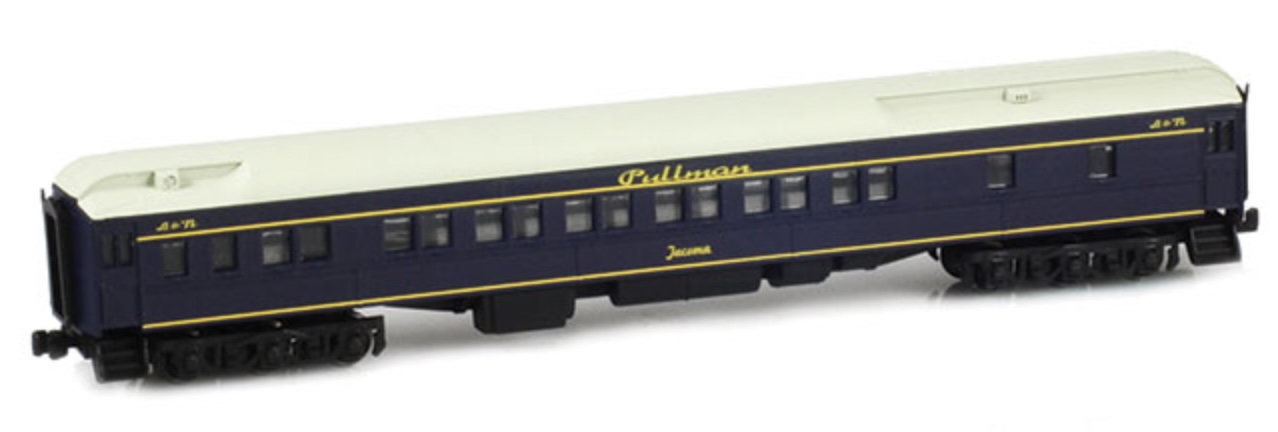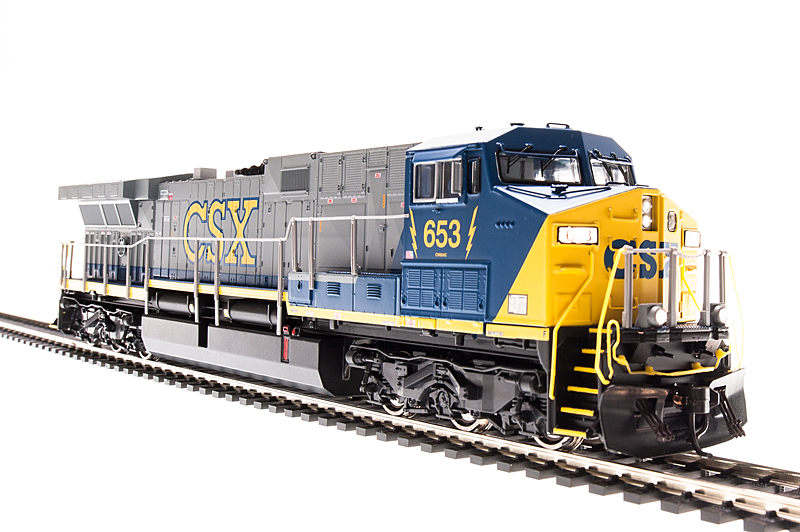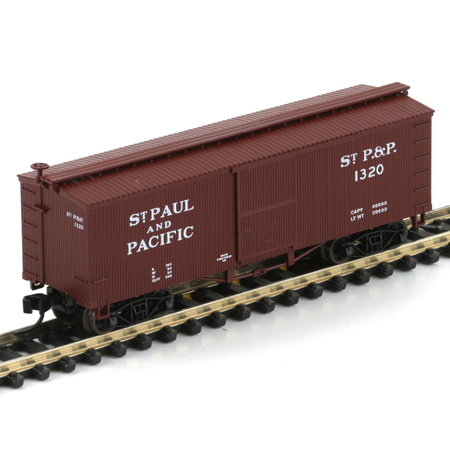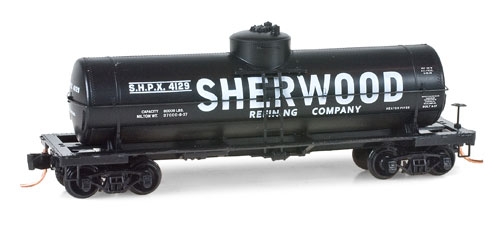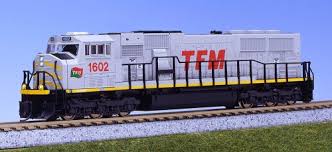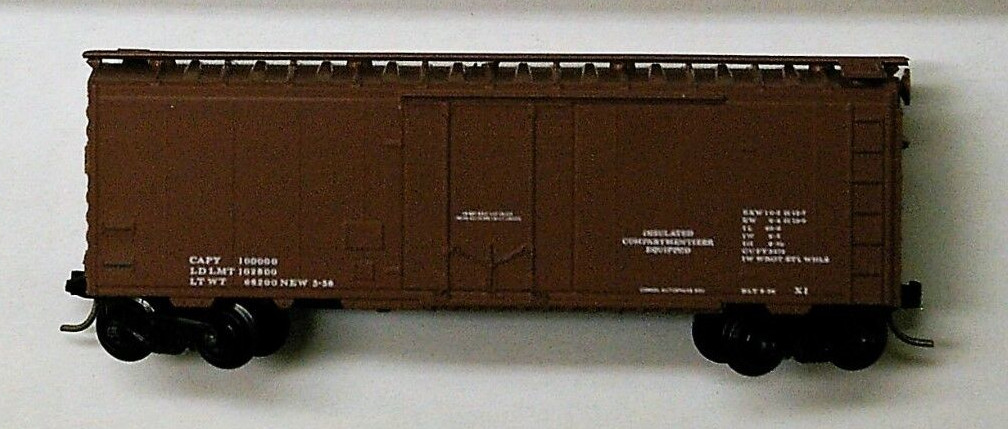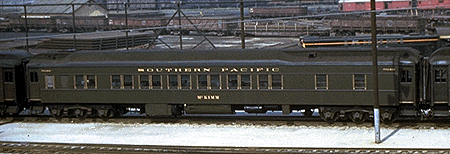Prototype History: Pullman was the leading producer of heavyweight coaches during the 1st half of the twentieth century. They were known for the quality and luxury of the passenger cars. The observation car was a common sight on heavyweight consists during 1920s and 1930s.
Sleeping, parlor and lounge cars of riveted carbon steel body-frame construction were built, owned and operated by the Pullman Company. These cars were better known by the name "Heavyweight Cars." Between March 1907 and February 1931 there were 8011 cars built.
The first steel passenger cars were 12-1 sleepers, such as this Plan 2410, which are simply a steel adaptation of the "Varnish" Plan 1963 car - "gothic" arched windows and all. 12-1s of the Plan 2410 and 3410 are one of the relatively few steel designs in true mass production: being churned out in 100+ lots for a total over 4000 units: 40% of the entire Pullman steel fleet.
The spread of accommodations is interesting: the lowest level of Pullman space - the open section - together with the best - a drawingroom. Sleeper cars have a relatively low occupancy capacity, and Pullman has long held to the open sections for maximum payload. The drawingroom on 12-1s is actually intended for families: the High And Mighty prefer all-room cars.
Some typical features of these cars are the two large restrooms (the mens room - at left - is also the smoking lounge while the ladies have a vanity table in their restroom). The drawingroom has an arrangement similar to the sections, plus a sofa which makes up into a third berth. The drawingroom, of course, has its own facility. Externally we see that the traditional clerestory vents have been replaced with the new sheet metal ventilators. These use the forward motion of the car to create a draft through the fore-and-aft openings which, in turn, causes a venturi effect drawing fresh air into the car through the center openings.
Sleeping, parlor and lounge cars of riveted carbon steel body-frame construction were built, owned and operated by the Pullman Company. These cars were better known by the name "Heavyweight Cars." Between March 1907 and February 1931 there were 8011 cars built.
The first steel passenger cars were 12-1 sleepers, such as this Plan 2410, which are simply a steel adaptation of the "Varnish" Plan 1963 car - "gothic" arched windows and all. 12-1s of the Plan 2410 and 3410 are one of the relatively few steel designs in true mass production: being churned out in 100+ lots for a total over 4000 units: 40% of the entire Pullman steel fleet.
The spread of accommodations is interesting: the lowest level of Pullman space - the open section - together with the best - a drawingroom. Sleeper cars have a relatively low occupancy capacity, and Pullman has long held to the open sections for maximum payload. The drawingroom on 12-1s is actually intended for families: the High And Mighty prefer all-room cars.
Some typical features of these cars are the two large restrooms (the mens room - at left - is also the smoking lounge while the ladies have a vanity table in their restroom). The drawingroom has an arrangement similar to the sections, plus a sofa which makes up into a third berth. The drawingroom, of course, has its own facility. Externally we see that the traditional clerestory vents have been replaced with the new sheet metal ventilators. These use the forward motion of the car to create a draft through the fore-and-aft openings which, in turn, causes a venturi effect drawing fresh air into the car through the center openings.
Road Name History: The Louisville and Nashville Railroad (reporting mark LN), commonly called the L&N, was a Class I railroad that operated freight and passenger services in the southeast United States.
Chartered by the Commonwealth of Kentucky in 1850, the road grew into one of the great success stories of American business. Operating under one name continuously for 132 years, it survived civil war and economic depression and several waves of social and technological change. Under Milton H. Smith, president of the company for thirty years, the L&N grew from a road with less than three hundred miles (480 km) of track to a 6,000-mile (9,700 km) system serving thirteen states. As one of the premier Southern railroads, the L&N extended its reach far beyond its namesake cities, stretching to St. Louis, Memphis, Atlanta, and New Orleans. The railroad was economically strong throughout its lifetime, operating both freight and passenger trains in a manner that earned it the nickname, "The Old Reliable."
Growth of the railroad continued until its purchase and the tumultuous rail consolidations of the 1980s which led to continual successors. By the end of 1970, L&N operated 6,063 miles (9,757 km) of road on 10,051 miles (16,176 km) of track, not including the Carrollton Railroad.
In 1971 the Seaboard Coast Line Railroad, successor to the Atlantic Coast Line Railroad, purchased the remainder of the L&N shares it did not already own, and the company became a subsidiary. By 1982 the railroad industry was consolidating quickly, and the Seaboard Coast Line absorbed the Louisville & Nashville Railroad entirely. Then in 1986, the Seaboard System merged with the C&O and B&O and the new combined system was known as the Chessie System. Soon after the combined company became CSX Transportation (CSX), which now owns and operates all of the former Louisville and Nashville lines.
Read more on Wikipedia.
Chartered by the Commonwealth of Kentucky in 1850, the road grew into one of the great success stories of American business. Operating under one name continuously for 132 years, it survived civil war and economic depression and several waves of social and technological change. Under Milton H. Smith, president of the company for thirty years, the L&N grew from a road with less than three hundred miles (480 km) of track to a 6,000-mile (9,700 km) system serving thirteen states. As one of the premier Southern railroads, the L&N extended its reach far beyond its namesake cities, stretching to St. Louis, Memphis, Atlanta, and New Orleans. The railroad was economically strong throughout its lifetime, operating both freight and passenger trains in a manner that earned it the nickname, "The Old Reliable."
Growth of the railroad continued until its purchase and the tumultuous rail consolidations of the 1980s which led to continual successors. By the end of 1970, L&N operated 6,063 miles (9,757 km) of road on 10,051 miles (16,176 km) of track, not including the Carrollton Railroad.
In 1971 the Seaboard Coast Line Railroad, successor to the Atlantic Coast Line Railroad, purchased the remainder of the L&N shares it did not already own, and the company became a subsidiary. By 1982 the railroad industry was consolidating quickly, and the Seaboard Coast Line absorbed the Louisville & Nashville Railroad entirely. Then in 1986, the Seaboard System merged with the C&O and B&O and the new combined system was known as the Chessie System. Soon after the combined company became CSX Transportation (CSX), which now owns and operates all of the former Louisville and Nashville lines.
Read more on Wikipedia.
Brand/Importer Information:  AZL is the leader in North American Z scale locomotives and rolling stock. Since 2000, AZL has released a vast variety of freight, passenger and locomotives. AZL continues to push the boundaries of Z scale with amazing details and incredible performance. No matter if you are looking to run steam, or the most modern diesels, AZL has something for you.
AZL is the leader in North American Z scale locomotives and rolling stock. Since 2000, AZL has released a vast variety of freight, passenger and locomotives. AZL continues to push the boundaries of Z scale with amazing details and incredible performance. No matter if you are looking to run steam, or the most modern diesels, AZL has something for you.

Item created by: CNW400 on 2021-07-20 10:44:39. Last edited by CNW400 on 2021-07-20 10:44:40
If you see errors or missing data in this entry, please feel free to log in and edit it. Anyone with a Gmail account can log in instantly.
If you see errors or missing data in this entry, please feel free to log in and edit it. Anyone with a Gmail account can log in instantly.


